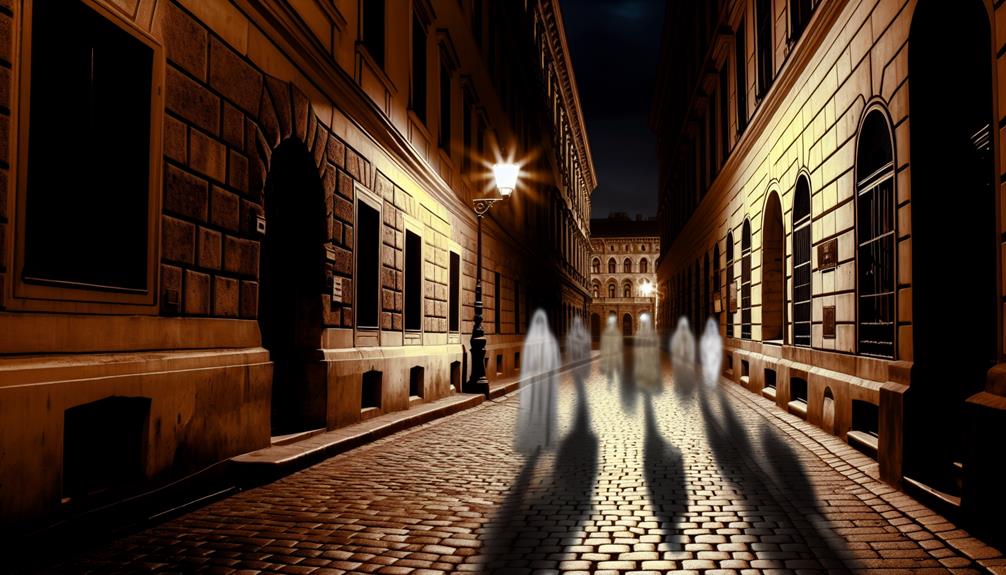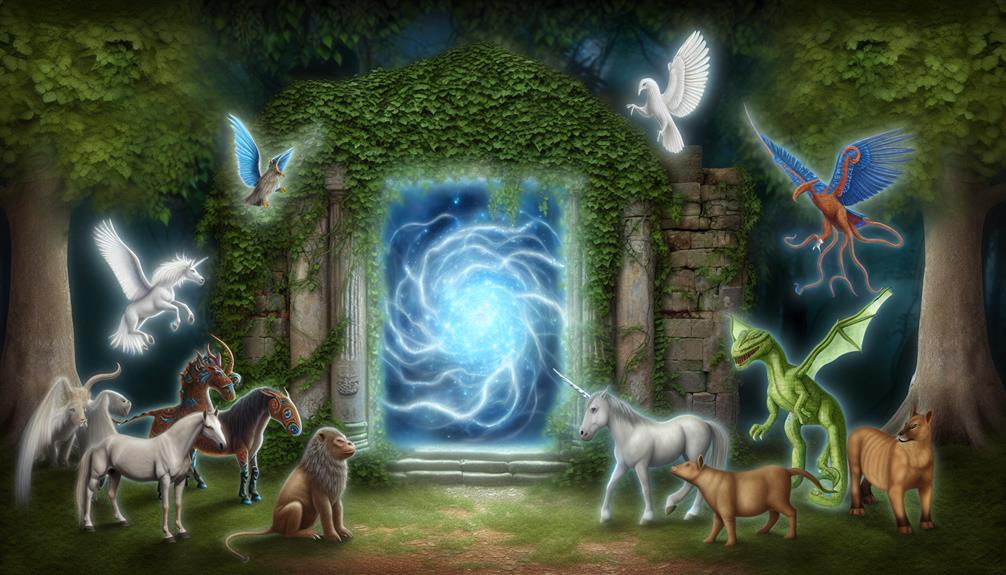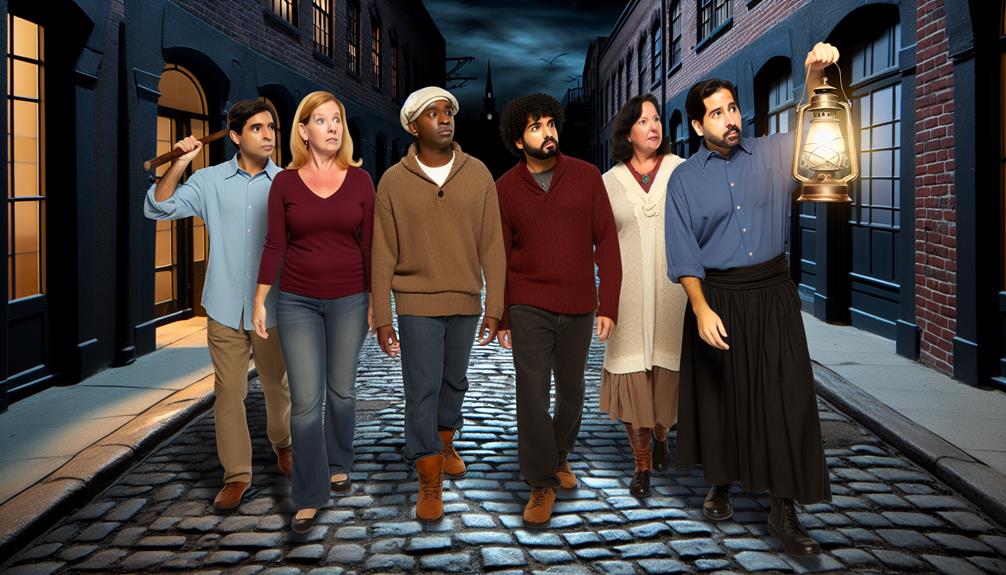Begin a journey through Budapest's enigmatic past on a spellbinding exploration of Hungary's dark history. As you wander the ancient cobblestone streets of Buda and Pest, you will encounter ghostly apparitions and uncover hidden secrets that have shaped the city's identity. From the eerie depths of Buda Castle to the haunting sites of Hungary's Revolution, each step reveals a new layer of mystery waiting to be unraveled. Join us as we peel back the layers of Budapest's dark history, where every corner holds a chilling tale begging to be discovered.
Key Takeaways
- Explore haunted Buda Castle with ghostly apparitions and tragic spirits in underground tunnels.
- Visit House of Terror museum in Pest for insights into Hungary's dark fascist and communist past.
- Discover haunted landmarks like Mary Magdalene Tower, blurring line between reality and paranormal.
- Learn about Budapest's historical trauma from World War II through memorials and bombed-out buildings.
- Join ghost tours to uncover supernatural mysteries in Budapest, including cursed objects and ghostly encounters.
Origins of Budapest's Dark History
The origins of Budapest's dark history can be traced back to a complex interplay of geopolitical, cultural, and social factors that have shaped the city's turbulent past. Throughout ancient times, Budapest, with its strategic location straddling the Danube River, was a melting pot of civilizations and beliefs. The city's history is marked by a tapestry of conquests, invasions, and shifting powers, creating a fertile ground for the emergence of dark and mysterious practices.
One facet of Budapest's dark history lies in the shadow of ancient curses. As different cultures and peoples settled in the region, their beliefs and superstitions intertwined, leading to the creation of legends and myths that still linger in the city's alleys and ruins. These curses, whether born out of fear or vengeance, have left an indelible mark on Budapest's collective consciousness, adding a layer of mystery to its already rich history.
Moreover, macabre rituals have also played a role in shaping Budapest's dark narrative. From esoteric ceremonies held in hidden chambers to sacrificial rites performed under the cover of night, the city has been a stage for practices that defy rational explanation. These rituals, often shrouded in secrecy, speak to a darker side of human nature that has found expression in Budapest's tumultuous past. The echoes of these practices still resonate in the city, whispering of a history steeped in enigma and intrigue.
The Haunted Legends of Buda
Amidst the ancient cobblestone streets and towering hills of Buda, a tapestry of haunting legends weaves through the city's storied past, casting a spectral veil over its historic landscape. Buda, with its rich history and architectural marvels, is also a place where paranormal activity is said to lurk in the shadows, adding an eerie confirmation to its already mystical aura.
One of the most famous haunted landmarks in Budapest is the Buda Castle, a majestic structure that overlooks the city from its elevated position. Legends whisper of ghostly apparitions wandering the castle grounds, tales of long-lost souls trapped within its walls, and mysterious happenings that defy logical demonstration.
Another spine-chilling site is the Labyrinth of Buda Castle, a network of underground tunnels and caves that have witnessed centuries of history. These winding passages are said to be haunted by the spirits of those who met tragic fates within their confines, adding to the sense of unease that permeates the air.
The Mary Magdalene Tower, with its ominous presence on Castle Hill, is rumored to be another hotspot for supernatural occurrences. Visitors have reported hearing disembodied voices, feeling sudden drops in temperature, and witnessing unexplained phenomena that defy rational understanding.
In the heart of Buda, these haunted landmarks stand as eerie confirmations to the city's enigmatic past, where the line between reality and the paranormal blurs in the flickering shadows of history.
The Dark Secrets of Pest
Discover the hidden underbelly of Pest, where shadows of secrecy cloak the city's past in a shroud of mystery and intrigue. Pest, the eastern part of Budapest, holds a trove of hidden secrets that whisper tales of its eerie landmarks and enigmatic history.
One such secret is the Labyrinth of Buda Castle, a network of caves beneath the castle that has witnessed centuries of clandestine activities and dark rituals. These winding tunnels are said to have been used for various purposes, including prisons, storage, and even alchemy experiments.
Another chilling landmark in Pest is the House of Terror, a museum that stands as a grim reminder of the atrocities committed during Hungary's fascist and communist regimes. This haunting building once served as the headquarters for the Arrow Cross Party and the communist ÁVH secret police, where innocent lives were shattered and lost.
Pest's hidden secrets extend beyond physical landmarks, delving into the world of political intrigue and espionage. The city's past is rife with stories of espionage, double-crossing, and covert operations that have left an indelible mark on its streets and buildings. Uncovering Pest's hidden secrets offers a glimpse into the darker chapters of Hungary's history, inviting visitors to explore a side of the city that is as intriguing as it is chilling.
Ghosts of Hungary's Revolution
As the shadows of Pest's dark past linger, the echoes of Hungary's Revolution reverberate through the city's streets, where the ghosts of defiance and struggle haunt the collective memory of a nation in upheaval. Haunted sites across Budapest serve as poignant reminders of the tumultuous events that unfolded during the revolution of 1956. Paranormal encounters reported by visitors and locals alike add an eerie layer to the historical significance of these locations.
One such haunted site is the Hungarian Radio Building, where a group of revolutionaries attempted to broadcast their demands for freedom over the airwaves. The building now stands as a spectral tribute to their bravery, with whispers of voices from the past echoing through its corridors late at night. Visitors have reported feeling a chilling presence and hearing faint, ghostly transmissions from the revolutionaries who met their fate within its walls.
Another haunting location is the Kossuth Square, where the revolution's leaders made impassioned speeches to the crowds gathered in support of their cause. The square is said to be imbued with the energy of their courage and determination, with some witnesses claiming to have seen shadowy figures marching in protest during the dead of night.
These haunted sites not only preserve the memory of Hungary's Revolution but also serve as a poignant reminder of the sacrifices made by those who fought for freedom and democracy. The paranormal encounters experienced at these locations add a mystical element to Budapest's historical narrative, connecting visitors to the spirits of the past in a profound and haunting way.
Mysterious Figures in Budapest
Throughout Budapest's storied streets and historic landmarks, enigmatic figures from the city's past continue to intrigue and beguile both locals and visitors alike. These cryptic characters and enigmatic entities add layers of mystery to the rich tapestry of Budapest's history.
One such mysterious figure is Countess Elizabeth Bathory, known as the Blood Countess. Legend has it that she bathed in the blood of young virgins to maintain her youth and beauty. Her castle, Cachtice, located in present-day Slovakia but close to Budapest, still evokes a sense of dread and fascination.
Another enigmatic entity is the Turul bird, a mythical creature from Hungarian folklore. Often associated with power and protection, the Turul plays a significant role in the country's history and symbolism. Its presence can be felt in various sculptures and artworks throughout Budapest.
Additionally, the mysterious figure of Attila the Hun, a fearsome warrior-king who led his people across Europe, holds a place in Budapest's historical narrative. His legacy is intertwined with the city's identity, reflecting a time of conquest and power struggles.
These cryptic characters and enigmatic entities serve as reminders of Budapest's complex and intriguing past, inviting visitors to explore further into the mysteries that shroud the city's history.
Shadows of Budapest's War History
The lingering shadows of Budapest's war history cast a somber and poignant veil over the city's landscape, serving as poignant reminders of the tumultuous events that have shaped its past. The scars left by war atrocities and historical trauma are etched into the very fabric of Budapest, whispering tales of suffering and resilience to those who pause to listen.
During World War II, Budapest bore witness to intense fighting, destruction, and loss of life. The city became a battleground, with its streets echoing the cries of civilians caught in the crossfire. The haunting remnants of bombed-out buildings stand as silent witnesses to the horrors of war, their crumbling facades a poignant symbol of the devastation wrought upon the city.
Visitors to Budapest cannot escape the weight of its war-torn history. Memorials and museums dedicated to the memory of those who perished serve as stark reminders of the human cost of conflict. The Shoes on the Danube Bank, a poignant sculpture along the river, pays tribute to the thousands of Jews who were shot and thrown into the river during the Holocaust.
Exploring Budapest's war history is a somber yet essential journey, shedding light on the dark chapters of the past while honoring the resilience of those who survived. It is a stark reminder of the consequences of hatred and intolerance, urging us to remember the past to secure a more peaceful future.
Uncovering Supernatural Mysteries
Emanating an aura of mystery and intrigue, Budapest's historical backdrop sets a fascinating stage for delving into the world of supernatural phenomena that have long intrigued both locals and visitors alike. The city's ancient buildings, cobbled streets, and rich folklore provide the perfect setting for exploring ghostly encounters and paranormal investigations.
When it comes to ghostly encounters, Budapest is no stranger to eerie stories and unexplained phenomena. From the haunted corridors of Buda Castle to the mysterious shadows that lurk in the Fisherman's Bastion, visitors have reported chilling experiences that defy logical explanation. These encounters add an extra layer of intrigue to Budapest's already enigmatic atmosphere.
To emphasize the prevalence of supernatural mysteries in Budapest, we can look at the following table:
| Types of Supernatural Mysteries | Locations in Budapest | Notable Encounters |
|---|---|---|
| Haunted Buildings | Buda Castle, Fisherman's Bastion | Apparitions, cold spots |
| Cursed Objects | Hungarian National Museum | Unexplained phenomena |
| Ghost Tours | Inner City Parish Church | Paranormal investigations |
Exploring Budapest's supernatural side through ghost tours and paranormal investigations offers a unique perspective on the city's history and culture, appealing to those with a thirst for the unknown and a fascination with the unexplained.
Frequently Asked Questions
Are Children Allowed on the Budapest Dark History Tour?
Parental discretion is advised when considering bringing children on tours with dark themes. For those seeking child-friendly alternatives, exploring historical sites, museums, or engaging in outdoor activities are excellent options.
It's essential for parents to evaluate the content and appropriateness of the tour for their children, considering factors such as age, sensitivity, and interest. Opting for activities that align with the child's curiosity and emotional readiness can promise an enriching and educational experience.
How Long Is the Duration of the Tour?
The duration of the tour is approximately 2.5 hours. The schedule typically includes a guided exploration of key historical sites with insightful commentary.
There are no specific age restrictions, but the content may not be suitable for young children. It is advisable to wear comfortable attire and appropriate footwear for walking.
Visitors can expect a detailed and immersive experience that explores the darker aspects of history.
Is Photography Allowed During the Tour?
Capturing memories through photography can be a cherished practice, yet certain settings may impose restrictions to uphold the sanctity of the experience.
When starting on a tour, it is essential to follow the established rules regarding photography etiquette. While some tours may allow unrestricted photography, others may have specific guidelines in place to maintain the integrity and respect of the tour's subject matter.
It is advisable to inquire about any photography restrictions beforehand to guarantee a seamless and respectful experience.
Are There Any Age Restrictions for the Tour?
Age restrictions for tours are common to guarantee appropriate content exposure. When considering tour content, factors like historical significance, graphic imagery, and thematic elements are vital in determining age appropriateness. Restrictions may vary based on tour themes and intensity levels.
Understanding the content can help organizers set appropriate age limits to ensure a meaningful and respectful experience for all participants. It is essential to balance educational value with potential emotional impact when establishing age restrictions for tours.
Can Visitors Interact With Paranormal Entities During the Tour?
Visitors may have the opportunity to interact with paranormal entities during the tour, where ghost stories and supernatural experiences are shared.
Haunted locations often serve as the backdrop for these encounters, creating an atmosphere of mystery and intrigue.
Participants should be prepared for potential interactions with the unknown, adding an element of thrill and suspense to the exploration of these dark historical sites.
Conclusion
To sum up, the dark history of Budapest is a haunting reminder of the city's tumultuous past.
One example that evokes emotion is the story of Countess Elizabeth Bathory, known as the Blood Countess, who allegedly tortured and killed hundreds of young girls in the 16th century.
Her legacy of cruelty still lingers in the shadows of Budapest, serving as a chilling reminder of the city's macabre history.


